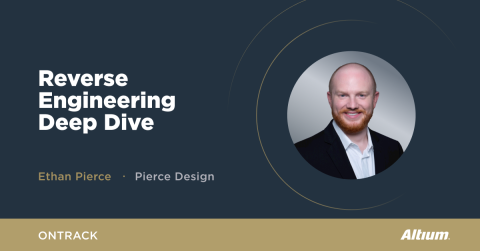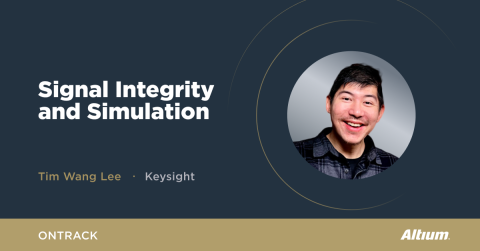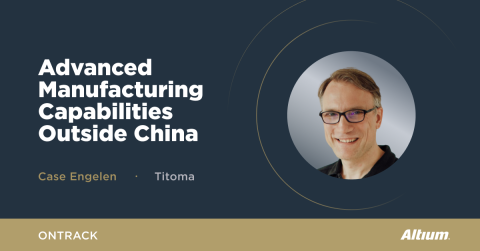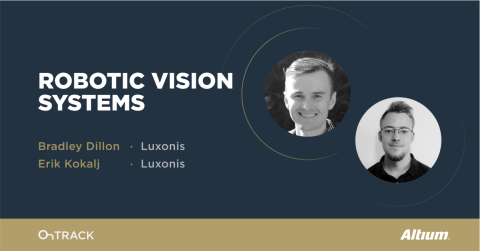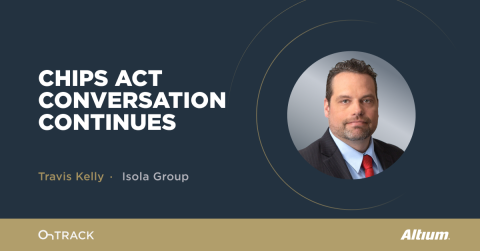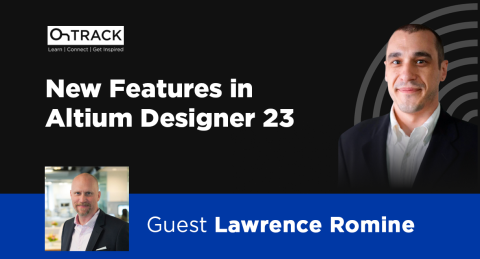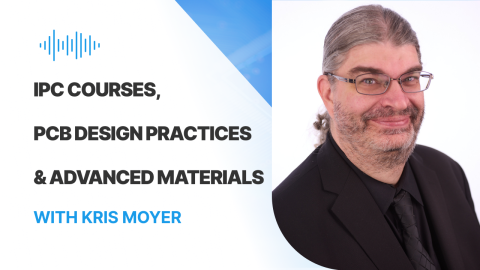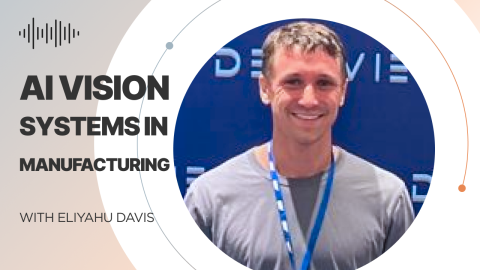Accessible Education for PCB Designers

One of PCEA’s (Printed Circuit Engineering Association) goals is to provide accessible education, affordable to everyone in the electronics industry.
In this episode, we are fortunate to have two passionate educators in the industry, Mike Buetow and Mike Creeden. We will talk about the PCEA’s efforts to use all possible platforms to promote educational programs for design engineers.
PCEA, it's an international network of engineers, designers, fabricators, assemblers…anyone who is involved in printed circuit development. And we promote Printed Circuit Engineering as a profession. We're looking at trying to take information, new design concepts, get them down into the manufacturing side, and then also to communicate those manufacturing constraints and make sure that they are communicated back to the design side. -Mike Buetow
Listen to Podcast:
Download this episode (right-click and save)
Watch the Video:
Show Highlights:
- Introduction to PCEA and updates on its acquisition of key assets of UP Media Group
- Mike Buetow talks about the PCB East conference reboot
- Who can benefit from PCEA’s educational initiatives?
- Mike Creeden emphasizes the importance of in-person learning. “Online is good, but it lacks some retention…but in-person learning, you retain more,” he explains.
- To collaborate, educate and inspire is what’s behind PCEA educational efforts
- PCEA is a volunteer-driven organization
- Mike Creeden will be at the https://www.ipcapexexpo.org/in San Diego
- Mike Creeden debunks misconceptions about PCB manufacturing facilities, the skills involved, the compensation, and more
- There are some issues in design education around packaging, the Insulectro booth at IPC Apex 2023 will offer valuable knowledge about packaging
- PCEA membership is free, you can register here
- Mentorship programs are something to look forward to
- Currently, PCEA has chapters in Europe, Mexico, Canada, Australia, and across the United States
Links and Resources:
- Visit PCEA’s website
- Connect with Mike Creeden on LinkedIn
- Connect with Mike Buetow on LinkedIn
- Watch Previous Related Episodes:
Get Your First Month of Altium Designer® for FREE
Transcript:
PCEA, it's an international network of engineers, designers, fabricators, assemblers, I don't want to forget them, really anyone who is involved in printed circuit development. And we promote Printed Circuit Engineering as a profession. It sounds simple, obviously in theory, but it's very difficult in practice.
Zach Peterson:
Hello, everyone, and welcome to the Altium OnTrack Podcast. My name is Zach Peterson, and I'm your host for today. And, of course, we are here talking with some important people from the electronics industry. Today, we're talking with Mike Buetow, president of the Printed Circuit Engineering Association, and Mike Creeden, executive director for membership at the Printed Circuit Engineering Association and technical director of Education at Insulectro. Mike and Mike, thank you so much for joining us. I know you both very well. I'll try to refer to you each as either Mike B. or Mike C. so that folks don't get confused. But thank you very much to both of you for joining us today.
Mike Buetow:
Thank you, Zach. It's good to be here.
Mike Creeden:
Glad to be here. Happy New Year to you.
Zach Peterson:
Yes. Happy New Year to you, both. I've known you both for a while and we always get to interact with each other at conferences, PCB West, PCB East, and you guys being part of PCEA, I think that is now, or that is now the two outlets where PCEA is getting most visibility. And there's been a lot that's been happening with the PCEA over the last year or so. So, I think I'd like to just jump right in and let you guys introduce yourselves, introduce the PCEA, and maybe we can talk about some of the great things that have been happening with the organization as it pertains to the industry and some of the great things that have been happening with recent acquisition of UP Media Group.
Mike Creeden:
Sounds good.
Mike Buetow:
MC, you want to go first since you're the big name in the room?
Mike Creeden:
Well, thank you kindly and, Zach, it's a pleasure truly to be here. And it's also exciting to just share what's been going on and what we see to be going on as we look forward. So, I'm just excited to be here at the beginning of this year. But just with a quick recap of 2022, we're actually celebrating two full complete years, the PCEA incorporated in January of 2020. And so, this will be our third year. Our second year '22 was just an exciting year, as you had alluded to with the acquisition of the UP Media Group and all its assets. There was a significant amount of work to make that happen. But the net result a year later is to say that the integration really has gone well, very smooth.
There was a lot of work I think, preparing for that before it happened, which did make it smooth in its first year. And so, again, there was a whole lot to do in '22 to make that happen. The nice thing though is again, and we're going to talk about moving forward, it allows us to, with more resources, meet some of the challenges that are in front of us. So, that's pretty exciting. I mean, to just recap, if I may, in bringing UP Media Groups assets into PCEA, first and foremost is our reach into the industry.
And again, Mike always could probably give you more accurate numbers than myself, but we're truly reaching hundreds of thousands, if not millions of people throughout the year with what they call an industry, some touch. And so, that includes the assets of the magazines that they have, Printed Circuit Board design and fabrication, and then also the Circuit's Assembly magazine. The other thing we do is we have trade shows. And so, we're going to talk a lot about PCB West, which is really the premier trade show for Printed Circuit Engineering professionals.
And we also have the Printed Circuit University and online learning platforms. There's quite a bit that goes into that, and hopefully, we can talk about that when we hit education. Other ways of reaching people, we've got the PCB today, which is a workshop series where a bunch of industry subject matter experts come and share their insight, and it truly becomes an educational platform that's unrivaled in the industry.
So, along with that, like this, we do podcasts and again, trying to just improve the industry. That being said, I'm going to applaud what you're doing here, Zach, to Altium's podcast series because I love the guests you bring on. I call myself grateful for being asked to participate.
Zach Peterson:
Well, of course, we're happy to have you. And you had mentioned PCB West as the premier show for Printed Circuit Engineering professionals, and I would definitely agree. But this last year, we actually had a reboot of, I guess its sister show on the East Coast, PCB East, and you and I were there and we actually chatted briefly. And Mike, we also, or Mike B., I should say, we also chatted briefly. Tell us about that reboot. How did that come about? How long of a pause was it, and then how would you gauge the success of that show?
Mike Buetow:
Right. Let me answer that, but let me, if I may just add to one thing that Mike Creeden was mentioning. For folks who don't know, because we are a new organization, just coming into our third full year. PCEA, it's an international network of engineers, designers, fabricators, assemblers, I don't want to forget them, really, anyone who is involved in printed circuit development. And we promote Printed Circuit Engineering as a profession. We're looking at trying to take information, new design concepts, get them down into the manufacturing side, and then also to communicate those manufacturing constraints and make sure that they are communicated back to the design side.
It sounds simple, obviously in theory, but it's very difficult in practice. So, we think of ourselves really as a bottom-up organization. We're focused on the individual as opposed to the business entity. And we'd like to help that individual no matter what part of the circuit engineering profession they're in, really get to the best, be the best person they can be in terms of career development, technical knowledge, and then hopefully, mentorship where they can give back.
So, with that framework in mind, PCB East and PCB West, as you mentioned, are both very important to what we do, right? Because that's really face-to-face training of engineers. And PCB East really filled a void that had been here in New England, which is where I'm based for over 10 years. It was the largest technical conference, really the only technical conference of its size in New England and over a decade that was aimed at Printed Circuit Engineering. We sold out the show floor, which was great. We had a very successful technical conference.
A highlight was Gene Weiner's presentation, is keynote, looking at emerging technologies. And that's really one of the things that we're trying to do at PCE is understand what is coming and then how to implement it from design to fabrication to assembly. So, that event was long overdue and very well received.
Zach Peterson:
Yeah, that's great to hear that it went so well. When I was there on the floor, it was a lot of activity. It's not the biggest space which I think was safe for the event itself, having come back after a bit of a hiatus. But it was great to see that there were so many people there at all of the different sessions. And then, of course, all the different companies there that were exhibiting. And I really like those shows because you get to see a lot of the things that you read about maybe in news articles or that you read about and like application notes, you get to actually see it up close and personal.
Mike Buetow:
Boston is the second highest area in the US in terms of venture capital, very big in medical wearables. Some defense work is still here. We don't have all the fabrication and the EMS side. There's lots of smaller EMS companies. It's nothing like California, of course, but there are a boatload of OEMs and some of them are brand names, Bose, EMC companies like that. But there are lots and lots and lots of mid-size and startup companies in the IoT space. And there's so much engineering talent that comes out of the colleges here. It's really a mecca for this.
And our conferences, what makes them different than what you'll see at a lot of other industry shows is that we don't focus on the 20-minute paper sessions. The median length of a session is two hours. So, that means some very in-depth technical training that's taking place. And you'll see as many, seven-hour sessions as you'll see one-hour sessions at PCB East or PCB West. So, we really focus on in-depth information that someone could take with them and apply to their jobs almost in real time.
Zach Peterson:
I'd like to dive a little bit deeper into that because if you look online, I think you'll see a lot of different possible types of design education. There's tool-specific education, which is usually offered by the CAD vendors. Then there may be tool-agnostic education at different levels of advancement. So, I'm wondering where do the educational initiatives that are being spearheaded by PCEA, where do those sit in the hierarchy of design and manufacturing education? And do you see them being focused more on design, CAD tool use generally, or towards manufacturing? Or do you guys really just try and hit everything? Or are you maybe more pulled by what attendees want? How do you prioritize?
Mike Buetow:
It's a great question, because it's something that we wrestle with in every single, leading up to every single conference. What is it exactly do we want to do? Are we going to center this around a particular technology, or are we going to make this as broad as possible to try to bring in the greatest, appeal to the greatest audience? And I don't think that there's a formula. I think sometimes, there's a technology that demands some attention. So, IoT popped on the radar a few years ago, and we had some speakers that have developed content specifically to those types of boards so that we're addressing a specific need.
But what that also does though, Zach, is it gets the attention of folks that are working in that space. I'll let MC talk to this in a little bit more detail, but Mike, who is intimately familiar with not just design, but also the material science and signal integrity and issues that can speak to how similar some of these issues are, regardless of what the end product application is. So, Mike, do you want to latch onto that?
Mike Creeden:
Yeah. Thank you. When you consider education, Zach, there's content and then there's delivery. And you broke it down really nice saying that it could tool specific and tool agnostic. And then, what discipline, and or then what sector is it taken in. We've named our organization very strategically, Printed Circuit Engineering, meaning engineering occurs at the assembly house, engineering occurs at the fabrication level, engineering occurs at the schematic level, and engineering occurs at the layout level. Also, you could throw in many ancillary things.
When you consider the amount of fabricators, what is it, approximately 183, pick a number across the land. They have engineering challenges, same thing with assembly houses, but there are hundreds of thousands of engineers throughout the OEM sector. So, it's trying to match content with delivery to the people that need it. It is a little bit more volume-driven by the OEMs, so we target that. Yet at the same time, fabricators and assemblers are very interested in what we have to say because who we're trying to educate are their customers.
So, they do pay attention and they show up at these sessions. We started out talking about technical conferences, which is a great time for the individual to get out there and partake of this, which has great excitement as opposed to online medium. Online is good, but it lacks some retention and it lacks something into delivery. We're all very grateful for it. The pandemic taught us that, but in-person learning, you retain more. And so, we're attempting to be as diverse as we can and adaptive to the needs that we see in front of us.
And people are always trying to learn what's emerging. They want to stay ahead of the curve technically. Because the challenges are hitting everybody, the technology curve is truly in the ramp-up level, much more so when it was like this, it is truly very steep, the technology curve. So, hopefully, that provides some of that insight. So, thanks for letting me share.
Mike Buetow:
And, Mike, if I could-
Zach Peterson:
Sorry, go ahead. Go ahead.
Mike Buetow:
Yeah, if I could just add one thing. MC is completely correct insofar as the online versus in-person types of events. There's obvious value in terms of being able to sit down in a session for three or five or seven hours with a Rick Hartley or Susy Webb or Mike Creeden, or Zach Peterson, and get expert opinion about a particular issue. Then there's also what happens after that, what I call the lobby caucuses, where the networking takes place that goes beyond that so that you start getting business cards and names and LinkedIn connections and the questions that you have that arise down the road can get answered very quickly.
Yeah, sure, somebody could reach out to you, Zach, or to Mike on LinkedIn and pose a question, but you don't necessarily know where they're coming from and what their story is and all that. And email is not always a good substitute for just this type of rapport. The other thing I'd like to add, again, segueing on to what MC said, is that the fabricators and assemblers, when we're looking at a conference, we always get a lot of design engineering abstracts, but we look at it and we say, "Okay, what is in here for the fabricator and assembler?"
Because when those folks come to our events, what you hear from them most often is that, "DFM is not how they think. It's really more MFD." It's like manufacturing for design or manufacturing... they're trying to figure out what the design constraints are. So, it's manufacturing by design like MBD, right? So, the enlightened assemblers really understand just how complex the design side of the equation is.
There's value for everybody when you get down to it. And we really try to make sure that there are manufacturing-related sessions at our conferences so that those folks on the manufacturing side of the equation understand that they need to be in this room too, that they need to be at this conference as well.
Zach Peterson:
I agree with you. Oh, sorry, go ahead.
Mike Creeden:
I would like to piggyback one final thing on that thought. And normally, Mike and I would say this in our opening sentence, is we have a mission statement and essentially, that is collaborate, educate, and inspire. It's truly at the heart of what we do. When Mike said we were a bottom-up organization, collaboration needs to come first and that's going to happen live and it's going to happen online. So, we're not trying to pit live versus online, we're trying to facilitate both. The post-pandemic world has made so many of us remote workers. So, there's nobody in the next cube other than my beagle over there in what we have is one another through online relationships.
And a lot of times, those relationships are formed in the live events. That collaboration then transcends into education where we're truly trying to, on the job, educate one another, enlighten one another, share technology wisdom or advancements. And from that, we all walk away a bit inspired. So, that's truly what we're trying to do when we say we're a bottom-up and that's why our membership is free. Back to you, Zach. Thanks for letting me cut in.
Zach Peterson:
Yeah, of course. I agree with you Mike B. about the manufacturing side of it. And I've said several times on the podcast with the guests that learning more about manufacturing in terms of the process and the operational side and quality and reliability and all of those granular things. I made it my mission over the last year to learn much more than I already knew. And it was really enlightening because in talking to people, you get to see how they have a bit of a different perspective in how they approach complex technologies and how they fabricate it. And it was something that I could only get by actually speaking with someone.
Usually, I'm doing it over a podcast, but you're absolutely right. It's that actual dialogue that you can have with somebody, even if it's mediated by the internet, where you can really get somebody's perspective and get answers to tough questions that are really difficult to find from Google searches.
Mike Buetow:
To your point, we've had situations where, like Gerry Partida from Summit Interconnect will talk about how folks are overdesigning certain boards, they're going smaller than they need to be and with the lines of spaces. And Lee Ritchey come on and chime in and agree. You've got two of the leading fabricator and design engineering folks in the industry talking about, "Hey look, you can make boards that are fundamentally simpler and yet get... they do all the functionality that you need and they're much more manufacturable. We don't expect everybody to walk through a manufacturing plant and become experts in imaging and how solder mask is applied and things like that.
But if you know some of the basics of the physics of the board, and this is where folks like Mike really I think earn their keep, then you're going to be a better design engineer. You're going to make the fabricator's life easier and everything is going to flow that much better.
Mike Creeden:
If I can piggyback with that too. One of the things that we've tried to put at the core of what we do in PCEA is what, Steph Chavez, our chairman actually coined the phrase of the designer's triangle. I serve in the IPC standards committee. We actually put this in the 2200 series in the first page, first paragraph, and that's the designer's triangle where there's three perspectives to truly make a circuit work. And a lot of times, you'll pull on one expert in manufacturing. Well, that's one perspective. Another time you might pull on another expert in signal integrity or performance.
Another time you might pull on someone with great expertise in the solvability, using your CAD tool, truly solving a dense high-speed digital or RF puzzle. And each one of those is radically important, but it's the hybrid of all three at the same time that truly what makes revision one work. We really try to stress that. And as Mike B. alluded to, when we have conferences, we have an educational committee that pools all the different papers that come together and we truly try to bring a balance of those three perspectives. So that we're addressing people who lack that information.
I'm a great designer and I know signal integrity, but I don't understand reliability or manufacturability. Well, come and hear that presentation. Or if you're a manufacturer, and you don't really understand what are the challenges that signal integrity people face, you can balance that out.
Mike Buetow:
MC, thanks for bringing that up because I want to underscore that. PCEA is not a staff-driven organization, it really is a volunteer-driven organization. Our education committee, which is really the foundation of the entire rest of the organization's initiatives is led by Tomas Chester. We have the conferences task group, which is led by Rick Hartley. We have the accessible and free education material path group, which is led by John Watson of Altium. So, you have folks that are giving their time on a volunteer basis because they see this as really critically important and we take our cues as a staff from them.
It's not the staff generating things for the membership to do, it's the other way around. The staff is there to carry the burden, the administrative burden so that the industry can talk to each other and train each other.
Zach Peterson:
You brought up an important point, which is that this is a way for people to essentially take some of that knowledge they've earned over time and give back. And you didn't say it explicitly, but I think that's one of the things that's really going on with the membership. And I actually posted on LinkedIn recently because I recently joined an IEEE standards group. And I post on LinkedIn that I think if you are someone who has earned some level of technical knowledge over time, that it's your responsibility to participate in these things. Whether it's a standards group, whether it's an organization like PCEA.
[NEW_PARAGRAPH]There are actually multiples of these out there to ensure that you're giving that knowledge back to people who need it.
Mike Creeden:
I highly concur with that. Serving as an executive board member in PCEA, I also serve as a committee chairperson at IPC. In the next couple of weeks from now, I will be in San Diego at the IPC Expo. And we're really excited because we're pulling together the 2221 and the 2220 design series. It's been 12 years that those documents and those standards are in rewrite. And so, we're finally bringing them to a new edition, which is exciting for the industry. We designed to those and we manufacture to those. And they're more than just guidelines, they're truly standards whereby, actually, they're legal requirements, they're binding requirements.
People a lot of times don't get that, but it improves reliability of our products and the integrity, the manufacturability, which again affects the bottom line. So, when companies send their people to these technical conferences and they follow the standards that we as volunteers and individuals contribute, we're helping company's bottom line because truly, if I do not have to build rev two or rev three and rev one will pass data and work, that's a win on the calendar. It's a win on the overall development costs and it can be a significant win in ongoing revenues through high-quality, reliable products.
Mike Buetow:
And, Zach, to your point, at PCB West last fall, one of the sessions, in fact maybe the best session was a panel discussion under the fundamental question, where's the design engineering profession going? And so, we had as panelist Jennifer Wasco who's an engineering director at Collins, we had Jonah Stevenson who's a hardware engineering lead at Google. Mike Creeden was on there. He has a training organization called PCE EDU, and Steph Chavez was representing PCEA. And we had Gary Ferrari who was representing the EPTAC, which does the IPC CID training.
But one of the things that came out was Jen pointed to how she's working, not just with local, technical like vocational schools, but she's going down into the grade school level to try to get people excited about engineering and just explaining to them, "Hey look, you've got your iPhones and your AirPods and things like that, and did you ever think about how these were designed and made?" And trying to get them interested in the idea of electronics engineering and manufacturing.
And one other really interesting observation she made was how, she's seen how video game players, people that are hardcore gamers seem to have the right, I'll say brain, okay, for lack of better word for circuit board design. She's like, "They think in 3D." If you've been playing Minecraft for a few years, you can walk right into an engineering, an electronic engineering job. It's a really interesting idea and we're going to need that, I think future thinking, long-range thinking in terms of how to keep building this industry.
Because as you see the amount of investment that companies are making today in North America and subsidized in part by the US government who said, "Hey look, this is a really critical field. We need this, this is part of our defense strategy is to have a homegrown full electronic supply chain." Then folks like Jen are going to be... the way that they see the world are going to be so important, especially the fact that they're willing to share that with the next generation. And we like to think, "Hey look, PCA offers the platform for folks to do that."
Zach Peterson:
Yeah, I couldn't agree more. I often wonder what can we do to get kids to really understand that this is the future. Tech is not just software. In fact, tech or software as we understand wouldn't even be enabled if it wasn't for folks I guess like ourselves who build all the hardware for it to run on. So, that's a very interesting insight that she found that folks who are into games like Minecraft are probably going to be some great designers in the future. And I've been asking some younger folks who were recent guests on the podcast, what got you into electronics and how did you end up here? And it's always a diverse set of answers.
I'm hopeful that we can figure out some ways to get the younger generation involved because the workforce crunch is not just in PCBs, as you guys have identified and as, like IPC in a recent report also identified, but now I actually follow someone on LinkedIn named Robert Quinn and he pointed out that the workforce crunch is also in semiconductors. It's at all levels throughout the industry where we're going to have this major workforce crunch.
And I'm hopeful that the next generation of engineers is not all focused on software, that they actually come in and do hardware and that hardware becomes the cool thing again.
Mike Buetow:
Lee Richey told me once that the reason why people make hardware is to run software.
Zach Peterson:
That's true.
Mike Buetow:
And he's like, "People are going to kill me for saying that," but he's right. Fundamentally, he's right. However, I do think it's critical to understand there is a vacuum of knowledge about manufacturing today in the US. The image is that the factory is this dark noisy place that's subject to temperature extremes. That just doesn't ring true with me. These are climate-controlled, clean, automated production areas. That's what you see when you walk into a factory in North America today.
Zach Peterson:
Yeah, there's almost this image that it's like, the 1800s in England during the industrial revolution. That's what a factory is.
Mike Buetow:
Right. Another thing that folks have to understand is that there's plenty of opportunity for on-the-job training, there's pay for skills, there's job enlargement and enrichment. There's flexible work weeks. That's not always well known to those who are looking at service sector types of careers. This is an educated sell. It's a long-range type of approach. Staffing's always been an issue in the electronics industry, even in the recession in 2008, 2009, all I heard from folks was, "We can't find anybody." It's something that really requires, I think, Mike referred to the design triangle earlier. It requires a triangle of industry and government and academia to solve this problem.
But first, you have to acknowledge there is a problem before you can solve it. I feel like we're inching toward that right now, which is good.
Mike Creeden:
When you speak of the labor shortage that's out there, engineering layout has always been an on-the-job type of field where a degree is not required. And many people came in through an apprenticeship-type model and industry has somewhat ignored the layout profession. I've been preaching this for a long time, but when you consider the needs, if I have 180 fabricators out there and each one supports hundreds of OEMs, the amount of OEM jobs for layout engineering is significant and layout is not being taught in university level.
I've literally reached out to about 30 of them across the country and they have no expertise to teach it. Even when offered a curriculum, they say, "Well, we don't have anybody that could actually administer it." We've offered it for free. And I know Altium, I've worked with Altium, trying to literally, we'll put Altium seats in your colleges. And there's inroads of success there. And Mike had alluded to John Watson doing that even at the junior college level.
All that to say is this vacuum is out there and academia is, in my opinion, and I'm throwing the gauntlet down here, is not doing their part. Therefore, we in industry need to, and there's a lot of initiatives. The House Bill 76, 77 and the National Defense Acts and stuff like that that's attempting this. But again, often these are driven by the fabricators, 180 of those as opposed to trying to solve the layout thing.
Over 15,000 BSWs graduate each year and none of them show up with layout expertise. And so, when we can bring them this expertise and add this to their suite of professional tools, we've truly enabled them to succeed. That's one of the reasons I want to passionately serve in this organization.
Mike Buetow:
And we talk a lot about problems, but the important thing is what are our solutions? What are our paths forward? The electronic design automation industry growing in terms of employment at something like 8% over the last couple of years. That's a really big number. Those are the number of new hires in that sector. You need to keep feeding that. And the solutions, I think, Mike is right that academia has not been involved in this with both feet or even maybe even a pinky toe. However, I'm seeing little hints of this.
Rochester Institute of Technology is now in its third semester with a design engineering program, or at least some seminars and coursework. Stanford started a printed circuit design class last semester and we had 30-something Stanford undergrads come to... they joined the whatever, 2000-something folks that registered for PCB West last fall.
So, we had a bunch of students walking the show floor, which 10 years ago would've been an anthem. But now everybody's realized, "Hey look, this is the next generation. We need to get these people involved. We need to talk to them. We need to let them know what this industry is all about." Mike mentioned John Watson who's doing things down in Southern California and you have Lorain Community College in Ohio that has a full-fledged SMT line and trains folks to be SMT operators.
You have little hints of this, but again, to Mike's point, I mean one of my neighbors is the president of New England Community College and I brought up what Lorain is doing to him and he said, "Yeah, no, that's a cyclical industry." And I'm thinking to myself like, "Hmm." All right, so you have four cars in your driveway and every one of them has probably at least $3000 worth of electronics in it. That doesn't feel very cyclical to me. That feels like a pretty busy healthy industry.
But they have to see the economics behind it. And that's where the OEMs really matter. The OEMs need to not only identify the need, but they need to be part of the solution. They need to start participating, I think not just the college but at the lower levels, sending their engineers in to talk to students and just get them to understand that there is life in engineering beyond coding for one of the social media companies.
Zach Peterson:
I couldn't agree more. And I think what you just highlighted is something very important, which is the massive disconnect between the knowledge that the OEMs have about what it is they build and the everyday person. Because I feel like there's still this huge perception that printed circuit boards are basically just an overblown way to wire computer chips together. And the real technology is the semiconductor and the government in the US at least has not done anything to push back against that.
Because if you look at the CHIPS Act, it's only chips. Like we're fighting to even get some of that allocated to packaging, which is basically just a more advanced circuit board. But even that's a struggle. And so, if that's a struggle, how do you think you're going to get the typical community college president to understand that nothing they enjoy in modern life would be enabled without printed circuit boards?
Mike Buetow:
Go ahead, MC.
Mike Creeden:
Thank you. I think it was Mike Kelly, I saw or listened to, said, "Well, chips don't float."
Zach Peterson:
Travis Kelly.
Mike Creeden:
Thank you very much.
Zach Peterson:
We're going to be having him again soon to talk about some of these developments.
Mike Creeden:
I apologize, I got his name incorrect. And I think that it is a 3D solution and you're seeing that with interposers, where 96% of that is all done offshore. And there's a lot of inroads of that starting to be being built on our shore. So, there is movement for that. But the whole industry's technology ramp up towards micro development is, it's coming on us real fast, and we're used to a slower ramp up. The ramp-up we're on now is very accelerated.
Zach Peterson:
This gets into some issues with design education around packaging. And I wonder if focusing on packaging is a backdoor way to get engineers to also focus on printed circuit boards. Because I've talked to multiple people on the podcast and off the podcast about packaging and substrate and interposers. And at a basic level, if you really want to boil it down, they all say that, "Well, yeah, it's essentially just a very fine line, fine spacing, printed circuit board. It's a more advanced version." So, printed circuit designers have an inroad to a new thing that they can design because they already have the skills.
They have the ability and routing skills, they know how to think about it in 3D. And so, they could certainly get into packaging. So, I'm wondering if a focus on packaging at the educational level and the academic level is another way to get people to focus on printed circuit boards because they're going to have to learn those same skills.
Mike Creeden:
Yeah. You're absolutely right with that, Zach. Here's a shameless plug. Come visit the Insulectro booth at Apex because we'll be speaking about that. The idea of packaging, most people understand that if you looked at a BGA, it is a small circuit board, but it's built with some materials that are not common materials. When you have a 25 micron or dielectric thickness, a one mil dielectric thickness, that's not a standard off-the-shelf material. The whole idea of mSAP, aSAP, the semi-additive, micro traces solving micro BGAs, et cetera. This is packaging at a next level.
And it is my opinion and my theory that packaging at some point needs to come onto the Bare Board itself. So, the Bare Board itself needs to evolve. I'm going to be speaking about that whole construct that we do mSAP and aSAP today, yes, on package designs. We even do it with what I call the exception rule. I know Eric Bogatin actually wrote a paper that when you have a four mil line and you need to pin escape with a one or a two mil line, but for a small distance, that is an impedance discontinuity that, yes, it produces a signal integrity reflection of sorts, but it's manageable.
It's in that one-quarter or one-sixth of, really the rise time distance, I'm talking technical here, but it's manageable. But we're not building that two mil line across the entire board at 50 mils. And I put to you that we're really trying to push in and get some involvement from the manufacturers to truly find out what the smallest buildable mSAP line, trace line can be using standard materials today. Because this will take our industry, it's my opinion from essentially the 100 micron, the four mil trace width, down to 50% of that to a two mil trace width using off-the-shelf materials.
And that will enable truly trying to bring some of that package scale development truly into today's circuit boards. And this will be upon our doorstep a lot sooner than people think. And so, I love the fact that the industry is starting to look at some of this. It's truly next-gen for what we're doing and it's exciting times.
Zach Peterson:
Yeah, totally agree. And that's another area where over the past year or so, I've realized I need to get much more familiar with mSAP and aSAP. So, hopefully, Tara Dunn will get on here and discuss some of that with us because I think this is something that a lot of folks still find to be esoteric and as you say, it's coming up quick. And I'm wondering how long is it going to be before that becomes the new standard processing.
Mike Buetow:
Tara's our vice chairman, and Anaya Vardya who is one of the licensees of aSAP, is also on our board. He's American Standard Circuits. So, they probably would be good people to have on and address that.
Zach Peterson:
Yeah, absolutely.
Mike Creeden:
Zach, one topic, and this is fun because I think all of us, the three of us would continue on for probably more than the segment would hold, but one topic I don't want us to pass on is some of, the direction for this upcoming year.
Zach Peterson:
Yeah, absolutely.
Mike Creeden:
With everything that's gone behind us now, we're on a much more secure footing to really reach out into this upcoming year. And our focus in this upcoming year is membership. More than that, I'm going to say the value of involvement. Now, from our vantage point, and we have these strategic planning meetings that are going on whereby we're truly, we view this from yes, an OEM perspective, we view this from a manufacturing perspective, but again, as Mike said, we're a bottom up. We truly want to have this at an individual perspective where your participation, our membership is free. I keep stressing that.
You can literally go register at pcea.net. And we're building up users, groups, our chapters as we call them, and they're international now. We've actually got chapters going in Europe, in Mexico, in Canada, in Australia, and across the United States. And so, we're meeting quarterly with the leadership of those to try to pass the vision on. And we're seeing that the Zoom remote platform or whatever we want to call this, the remote platform, is really helpful because it's reaching people that are remote and never could come to the events that used to happen regionally or locally because they could drive there.
So, we're really excited about this new reach that we're having across the land. And, MB, you want to share anything on that?
Mike Buetow:
You can go to, as Mike said, to pcea.net and sign up not just as a member, but also if you want to be involved as a mentor or a mentee. And in fact, I think, what is it, two of our board members, Mike, our current board members, we found as, they originally were mentees.
Mike Creeden:
Correct.
Mike Buetow:
Now one of them is a regular speaker at our conferences and doing training for Altium. It doesn't take much to get involved and they're already seeing the benefits of it. One of our strategic goals, because this year, we did our first strategic plan and one of our strategic goals is an accessible education at a price point, affordable to anyone. And we mean that. We want to be able to offer all in-depth technical presentations, whether they'd be white papers or recorded webinars through our Printed Circuit University platform. And it's free to PCA members. We want to enable that access to technical expertise.
We want to help our constituents find colleagues and vendors and technologies. And for that matter, we want to help vendors find customers, the lead generation part, because we do have corporate members as well now. But those are really our four strategic goals. And the focus this year really is on that membership.
The integration is in the rear-view mirror and we can start building back the chapters and getting through our message that this is about networking, sharing of technical knowledge, helping each other grow in their careers.
Mike Creeden:
The mentorship program has really been exciting. We've had examples where someone will show up and say, "I'm in this particular area." It was a marine electronics up in the northwest, actually, in Vancouver area. And that person was mentored for the better part of a year. And at some point, mentoring fulfills its accomplishment and you've invested in a person. Well, then, a year later, another person showed up in the northwest, it was in Seattle area, and said, "I'm also in marine electronics."
I said, "Well, I want you to call this person here." So now, we have what's called third-generation mentoring occurring. In this day and age of remote operation, my beagle doesn't know electronics that well, but people that I meet throughout this industry can mentor one another. And that's an incredible thing. And it's just really participation and involving yourself.
Zach Peterson:
Yeah, totally agree. And I think the mentorship is always great. Sometimes it's just nice to have access to a person where you can just get a straight answer from somebody rather than spending hours searching the internet.
Mike Creeden:
Right.
Zach Peterson:
Well, guys, we're getting towards the end of our time slot for this, but I want to thank you both so much for joining me today. It's always great to hear about what's going on with PCEA. And I think the organization is so important, especially in terms of its mission of educating the next generation of designers.
Mike Creeden:
Nice. Thank you for having-
Mike Buetow:
Thank you, Zach, for the opportunity. It means a lot.
Zach Peterson:
Absolutely, absolutely. And, of course, we'll have you on again, I'm sure in the future. To everyone out there listening, we've been talking with Mike Buetow, president of PCEA, and Mike Creeden, executive director of membership at PCEA, also technical director of Design Education at Insulectro. To everyone out there listening, make sure to subscribe. You'll be able to keep up to date on all episodes and our tutorials as they come out. And, of course, don't stop learning, stay on track. And we'll see you next time.


